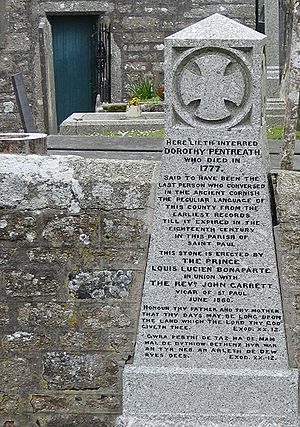Dolly Pentreath facts for kids
Quick facts for kids
Dolly Pentreath
|
|
|---|---|

Pentreath in an engraved portrait of 1781
|
|
| Born |
Dorothy Pentreath
|
| Baptised | 16 May 1692 |
| Died | 26 December 1777 |
| Nationality | Cornish |
| Other names | Dolly Jeffrey |
| Occupation | Fishwife |
| Known for | Being the last fluent speaker of the Cornish language |
Dorothy Pentreath (baptised 16 May 1692 – 26 December 1777), often called Dolly, was a very important person in the history of the Cornish language. She is known as the last person who spoke Cornish as their first language. This means she learned Cornish naturally from birth, just like you learn English or another language at home. She is also the most famous of the last people who could speak Cornish fluently.
Contents
About Dolly Pentreath
Her Early Life
Dolly Pentreath was baptised on 16 May 1692. She was the second of six children born to Nicholas Pentreath, a fisherman, and his wife Jone. Dolly later said that she didn't speak any English until she was 20 years old. Whether this is completely true or not, Cornish was definitely her first language.
When she was older, Dolly remembered selling fish in Penzance. She would speak Cornish, and most people living there, even important families, understood her. She lived in the village of Paul, which is very close to Mousehole. Dolly had a son named John Pentreath, who was born in 1729. He lived until 1778.
People described Dolly as a strong, older woman who was very important to the Cornish language. She was a fishwife, meaning she sold fish. She carried her fish around the areas of Penwith and Penzance. In Penzance, she became known as the last person to speak Cornish as their native language. Some people aren't sure how much Cornish she could really speak. But everyone agreed she was very good at swearing in Cornish!
Later Years and Legacy
In 1768, a man named Daines Barrington traveled around Cornwall. He was looking for people who still spoke the Cornish language. In Mousehole, he found Dolly Pentreath. She was about 82 years old and sold fish. Barrington said she "could speak Cornish very fluently."
In 1775, he wrote about her in a journal called Archaeologia. His article was titled "On the Expiration of the Cornish Language." Barrington mentioned that Dolly lived in a small hut. He also found two other women nearby who understood Cornish, even if they couldn't speak it as well as Dolly. Five years later, Dolly was said to be 87. Her hut was poor, and she was helped by the local church. She also earned some money by telling fortunes and speaking Cornish.
In her final years, Dolly became famous locally because of her knowledge of Cornish. Around 1777, a painter named John Opie painted her picture. Later, in 1781, an engraving of her was made from a drawing by Robert Scaddan.
A fisherman from Mousehole named William Bodinar said that he and Dolly used to talk for hours in Cornish. He said that almost no one else understood their conversations. But both Dolly and he could also speak English.
Dolly Pentreath is famous for her fiery temper. Legend says she would curse people in a long stream of angry Cornish words. She was even said to be a witch by some. Her death is often seen as the end of Cornish as a language spoken by a whole community. Many stories are told about her, like her calling people "kronnekyn hager du" (an "ugly black toad"). We don't know if all these stories are true.
Her Monument
Dolly Pentreath was buried in the churchyard at Paul. In 1860, a special monument was placed there to honor her. It was put up by Louis Lucien Bonaparte, who was a nephew of Napoleon, and by the local Vicar of Paul.
The monument says that Dolly Pentreath died in 1777. It states that she was the last person to speak the old Cornish language. It also has a Bible verse in both English and Cornish.
There was some confusion about where Dolly was actually buried. Some people believed the monument was not in the exact spot of her grave. However, in 1887, the monument was moved to what was believed to be her unmarked grave. A skeleton was found there, which people thought was hers.
The Last Cornish Speaker?
Dolly Pentreath is known as the "last native speaker" of Cornish. But like with many "last speakers" of languages, there's some debate about this. Her main importance is that she was the last person who spoke Cornish fluently from birth.
After Dolly died, Barrington received a letter from William Bodinar, the fisherman. Bodinar wrote in Cornish and English that he knew five other people in Mousehole who could speak Cornish. Barrington also mentioned a man named John Nancarrow from Marazion who spoke Cornish as his first language and lived into the 1790s.
There were other people who spoke traditional Cornish even after Dolly. For example, John Mann, who was alive in 1914, spoke Cornish with other children when he was young. Other speakers in the 1800s included Jacob Care, Elizabeth Vingoe, and John Davey. So, while Dolly was very important, the Cornish language didn't completely disappear with her.
See also
In Spanish: Dolly Pentreath para niños


